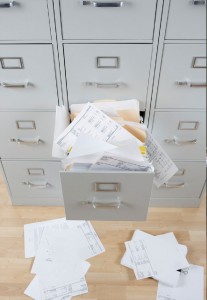How to Organize Important Documents, Part 3
 Welcome to Part III of How to Organize Important Documents. You can read Part I here and Part II here.
Welcome to Part III of How to Organize Important Documents. You can read Part I here and Part II here.
At the end of Part II, I said we would talk about how to manage your current financial records, and here it is.
Organizing Current Financial Records
What do you do with all the everyday financial records—household bills, brokerage statements, IRA records, paycheck stubs and bank statements? Well, if you’re me, you see how many of them you can have sent to you electronically instead of in the mail. I pay as many bills as possible online and it’s a simple matter for me to store the statements by year in a “finance” file on my computer. When I need a receipt for an online payment, I save it as a PDF instead of printing it out. I’m pretty sure I’ve saved a small forest by now, not to mention the wear and tear on my printer and shredder.
For bills that come in the mail and need to be paid the same way, I have a 3-ring binder with slip-in page protectors that I use as storage pockets. One pocket holds stamps, one holds envelopes and another holds return address labels. The remaining pockets hold personal correspondence that needs to be addressed and business correspondence that needs to be addressed. And then there is a pocket for personal bills and one for business bills. As the bills come in the mail, the envelopes are opened, all the stuffers removed and the bill and its payment envelope go into the appropriate pocket.
On my designated bill pay day (ok, my husband’s designated bill pay day because I hate doing it), he just gets out the notebook, pulls out what he needs and pays them and the book goes back on the shelf until the next week. Once the bill is paid, it gets filed. If a document or bill will be needed for taxes at the end of the year, it either goes into a file folder marked “current taxes” in the financial drawer of my file cabinet or into a computer folder of the same name if it’s an electronic statement.
For everything else—utility bills, credit card receipts, etc.—we only keep those for six months. Every six months, I clean out the files and we start over. Bank statements get kept for a year, as do pay stubs. Once we have a W-2, the pay stubs get shredded. Annual brokerage and IRA statements get kept permanently. Bills are sorted into file folders by type of expense. All credit card statements go in one folder together. All utility bills go in one folder together. All medical bills go into one folder together (medical records are filed individually by patient name–I don’t store medical bills and medical histories together). I do keep all of my bills and financial records together in one drawer of the file cabinet. This makes both filing and retrieval much easier. Within that section, I store the folders alphabetically.
Because I’m very lazy smart, I time my six-month purge for the month that the local shredding company has a free drop-off. I toss all my papers into a box and drop it off for them to shred. This way I don’t have to spend hours at the shredder and there’s no mess to clean up afterward.
Now that all your important papers are sorted, you can turn your attention to all those magazine articles, recipes and really great ideas you’ve clipped and saved. But this was plenty of work for one day, so I’ll cover that in my next article of the series.
How do you keep track of your bills? If you have a system that works better for you–meaning you can easily put your hands on a bill without having to hunt through all your drawers or dig through piles–I’d love to have you share it. I am always up for great new ideas, so please be sure to leave your comments and questions in the comment section below.
And if you found this helpful or interesting, please use the buttons below to share it with your network.







I pay every single bill online. I request paperless statements and invoices. If I need something for tax purposes I simply go into my online ‘history’ and print it out. I cannot express enough how much more simplified life has become using the online bill pay method.
BTW, you may have addressed this in an earlier post ~ regarding the sale of real estate. Keep EVERY SINGLE home improvement receipt. If you’re not rolling over into another property and want to avoid capital gains the IRS will want proof of improvements (as I’ve recently experienced). I kept every receipt from the ground up construction and improvements of my last home. I listed them all on a spreadsheet which makes it plain and simple for an agent to go through. If you’ve ever been through a tax audit you’ll appreciate having kept solid records . . .
Great points, Darris. We, too, pay every bill we can online and create PDFs of the ones we will need for tax purposes. It has made life immensely easier.
And I definitely second keeping those home improvement receipts. We have had a few fixer-uppers over the years and being able to document all of our repairs and improvements really paid off when it was time to sell.
Love being organized! I am gaining insight for your posts for sure 🙂 Thanks !!
GREAT Post Marie!
We have gone paperless on all our bills now, and it keeps the files so much thinner. In fact I was just commenting to hubby that we could actually put the acct. info into our Home Journal and toss all the files.
We are definitely moving in the paperless direction. I love being to have it all online. It makes keeping track of everything so simple and tax prep is a breeze.
The only bill I still pay by cheque is the rent. Everything else gets paid online. Bills and other paper documents get filed in the bottom drawer of my desk and then after taxes get moved to a storage bin to make room for the next year. Of course all this assumes that I actually do the filing and don’t just let it pile up in the to-be-filed basket. 🙂
I just keep my paper bills in a small pile on my desk, and then they all get paid at the same time at the end of the month. I’m with you on the e-bills, though. It’s so easy to pay and then save in a virtual folder. My bill folder where I store paid bills certainly has thinned out over the years!
I love your system, Marie. I always get caught up on how long to keep documents. I shredded so many documents on this last move. Thanks for the tips!
You are most welcome. I had so many things to shred after our last move–I loved finding out that a local company has a free shred month here a couple of times each year. No more being chained to the shredder or cleaning up the mess.
Once you have a system in place, you can quickly save and find related documents in their respective folders..
I am SO glad I stopped to read this post, because it led me to 1 and 2 and good golly but did I need this information! Thank you! And your website is gorgeous! Fresh, clean and easy to read. Kudos!
Great, Liz. I’m so glad you’re finding the series helpful. We still have a couple more to go so be sure to check back over the next couple of weeks–and those file cabinets will be all pretty and clean. Then maybe we’ll tackle the guest room closet (yikes!). And thanks for the feedback on the new site look. I am loving it, too.
Organize your tax returns. The Internal Revenue Service (irs.gov) has up to six years from the date you file to audit you or challenge your returns. Keep copies of tax returns and supporting documents such as receipts for charitable contributions and miscellaneous deductions. There is no statute of limitations on investigations of taxpayers who fail to file or who file fraudulent returns.
That is right, Ileana, though it is actually seven years, and as you pointed out can be longer if the IRS believes you filed fraudulently. I address the organization of tax documents in Part 1 of this series. Tax returns themselves should be kept forever and supporting documentation up to seven years.